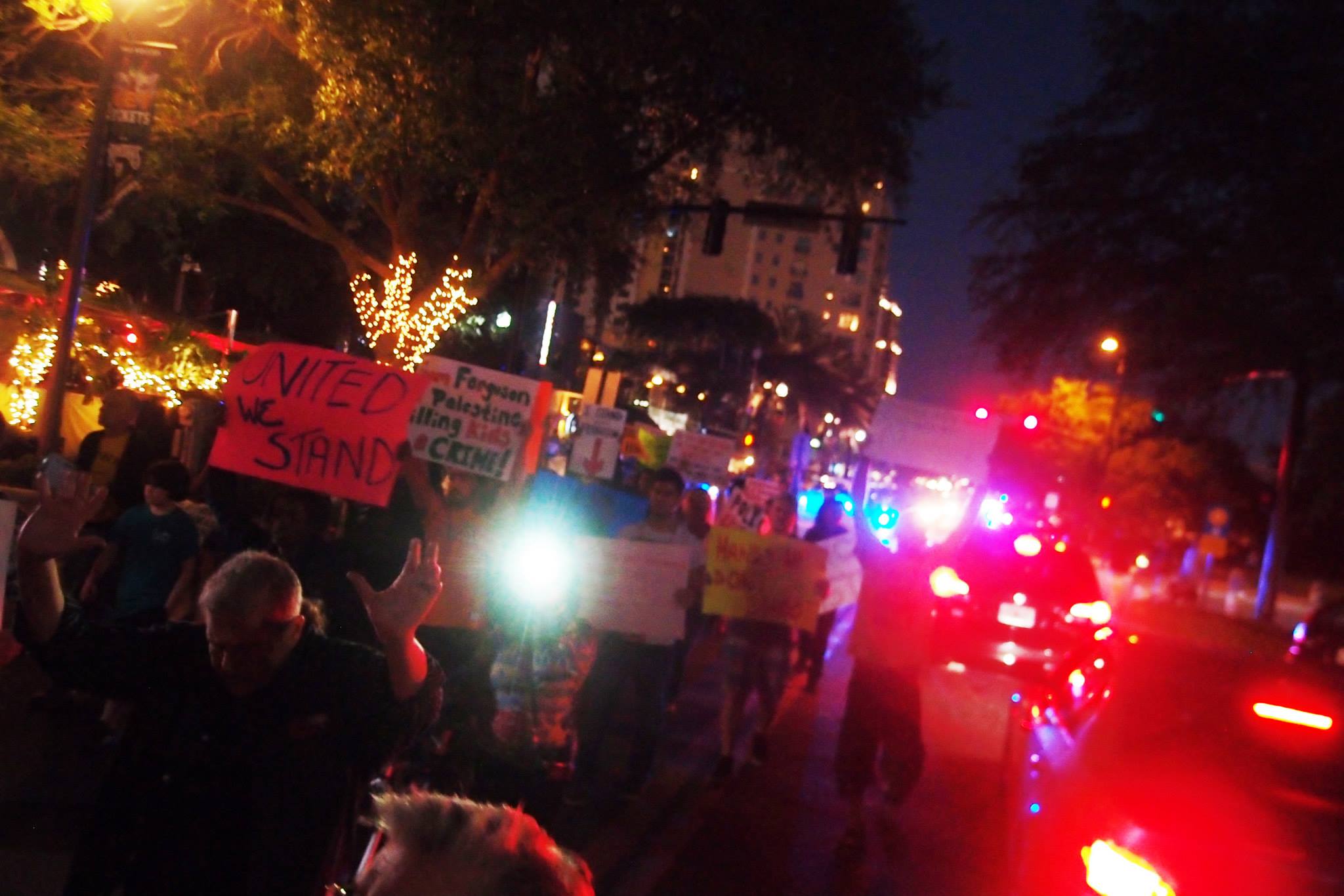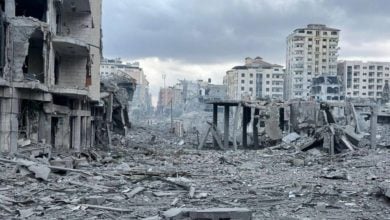 On December 6, activists and community members from around the Tampa Bay area rallied in Williams Park in St. Petersburg, Fla., before taking to the streets to demand justice for Mike Brown, Eric Garner, Elias Guadarrama and other victims of racist police terror. Attended by numerous organizations, including the Uhuru Movement, Anonymous and A.N.S.W.E.R. Coalition, the militant march and die-ins brought St. Pete to a standstill for an hour and a half in one of the largest actions the city has seen in recent months. Liberation spoke to several activists and organizers of the “March for Justice.”
On December 6, activists and community members from around the Tampa Bay area rallied in Williams Park in St. Petersburg, Fla., before taking to the streets to demand justice for Mike Brown, Eric Garner, Elias Guadarrama and other victims of racist police terror. Attended by numerous organizations, including the Uhuru Movement, Anonymous and A.N.S.W.E.R. Coalition, the militant march and die-ins brought St. Pete to a standstill for an hour and a half in one of the largest actions the city has seen in recent months. Liberation spoke to several activists and organizers of the “March for Justice.”
Chardonnay Singleton, a 27-year-old Tampa Bay activist, explained what she
hoped the nationwide movement sparked by the Ferguson uprising would accomplish.
“Ultimately, I hope that there is some form of self-determination for the Black community. Because we are all aware, as Black women and men, just how much the police harass and hunt us. They are literally hunting us. I live in West Tampa right now and if I drive down Main Street, I get followed. The fact that these police officers are hunting Black people, killing them on the street and getting away with it…they need to be held accountable for their actions, and the Black community also needs some way to protect themselves against what you could even call a slave patrol,” said Singleton.
Singleton also spoke to Liberation about solutions.
“To be perfectly honest with you,” she said, “I think Obama is an apologist only trying to appease both sides right now and still maintain some sort of approval rating, which is not going to happen. So his introducing the body cameras, that in some ways maybe can help, but we saw that Eric Garner’s whole incident was filmed and the cop still got off without a scratch. I think that the majority of the work has to happen on the local level. For example, in St. Petersburg, we all know about Javon Dawson and TyRon Lewis, the killings of unarmed Black men in the South Side here. So there’s local cases all over the country. We can have activists use those examples of how it’s happening in their own backyards and take a stand on the local front.”
Kofi Hunt, a 32-year-old organizer for Awake Pinellas and Florida Progressives, talked to Liberation about the effects of the protests shutting down cities across the country, and what he hopes to see come from them.
“They’ve caused enough of a stir that it’s reached that point where the institution is looking for ways to appease the masses. The current generation in a lot of ways is very frustrated with the power structure. They believe, I think rightfully so, they lack a lot of ownership, a lot of buy, so they don’t feel an incentive to negotiate. They don’t trust the people they’re demanding anything from. So I don’t see a lot of demands being put out there. I’m personally a part of an effort in St. Pete to change the city charter to allow for a portion of the city budget to be set aside for community budgeting, so I’m all down for direct democracy and community control. But, from my angle, I’m looking for those points that will build change,” said Hunt.
Like Singleton, Hunt was also unimpressed by the Obama administration’s response to the movement still shaking the country.
“I think that what Obama and Eric Holder has announced is not much,” he said. “It’s a step in the right direction, but I’ve found in doing this work that the higher up people go in government, they’re moving in molasses. Like, the president trying to do something at a grassroots level is like a giant picking up a pin. He doesn’t have the function of his office to do small-scale grassroots things, so the most he can do is broad, sweeping policies that will never directly target the immediate concerns. I do like the fact that there is some movement from the White House to try to do something, as that creates a better climate for work to be done on the ground. But I think that the real work is going to come from communities advocating for what they see needs to happen.”
Ashley Johnson, a 28-year-old activist who works with many groups, including Dream Defenders, Anonymous and FCAN, also helped organize the March for Justice. She told Liberation how personal experiences with racism motivated her.
“At the end of the day, there are personal experiences that drive me. I see the differences, I see the disparity and I feel them. I’ve experienced things myself. When you work hard to try to make yourself blameless in the world, by being good and doing good by others, and yet you’re still on the receiving end, you know there’s a problem. And not only me, but the people I love who are Black and who are Brown. Like, ‘Man, those are good people, why are they being treated a different way?’ Those things can weigh on you as you move through life. It’s just important for me to act against those pressures,” said Johnson.
Johnson spoke to Liberation about the importance of spreading awareness and how the people have been gripped by unrest.
“I think it starts with awareness, and that’s where these events of activism come in. Awareness is very important. Because now people see that pain. Now there’s a group of people who are no longer comfortable with the way it is, with the status quo. The best word I can put to it is ‘unrest.’ They are at a point of unrest, and they’re probably not going to rest until their needs are met. Because watching these issues, it’s hard to sit comfortably with them. Awareness needs to drive action in communities.”
The people of St. Petersburg marched up from Williams Park, down to Beach Drive, then back up Central Avenue to Central and 4th Street, where they staged their first die-in. There, 100 protesters lay in the intersection or stared silently into four lanes of headlights and rows of militarized police. Then they marched back to Beach Drive and ended up on Beach and 2nd Avenue, staging a second die-in. From there they marched back to Williams Park.
Chardonnay Singleton explained the significance of the die-in locations.
“I think both of those locations are relevant, Central and 4th to block off the traffic, like ‘no more business as usual, you need to open your eyes and see what’s going on,’ and the same thing happening on Beach Drive. Those people were enjoying probably ten dollar mimosas and thirty five dollar plates. They were enjoying their privilege and ignoring what’s going on in the world. They needed to see what was happening. This is a wake up call.”






